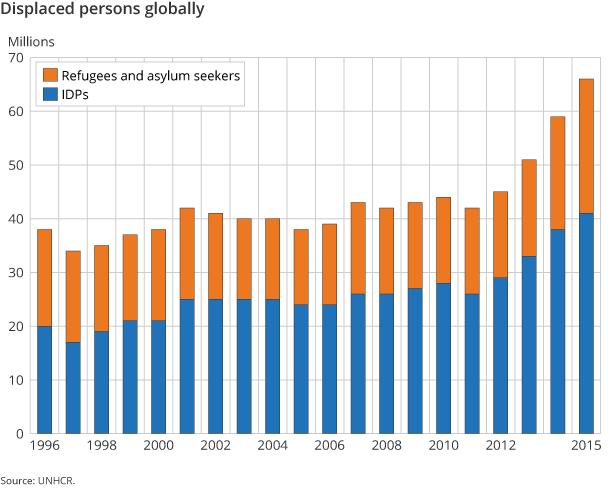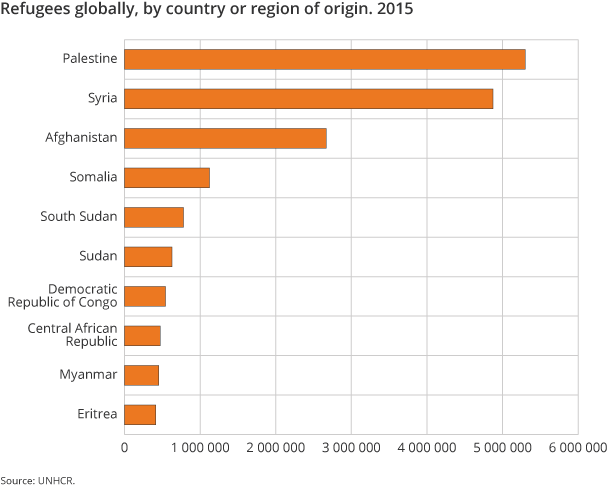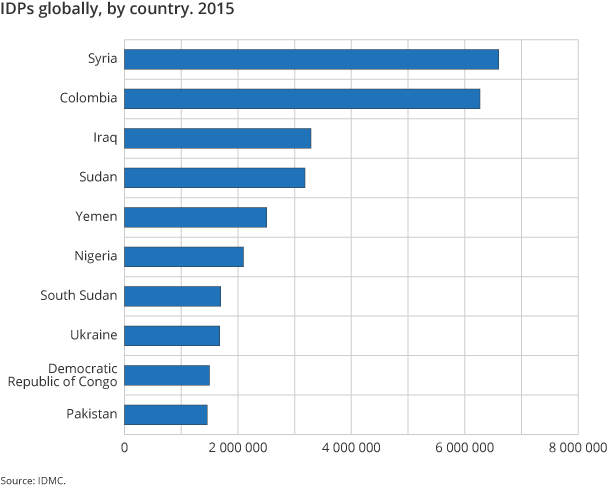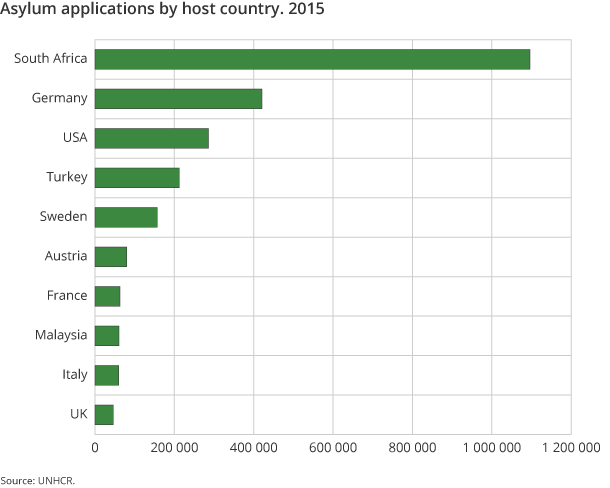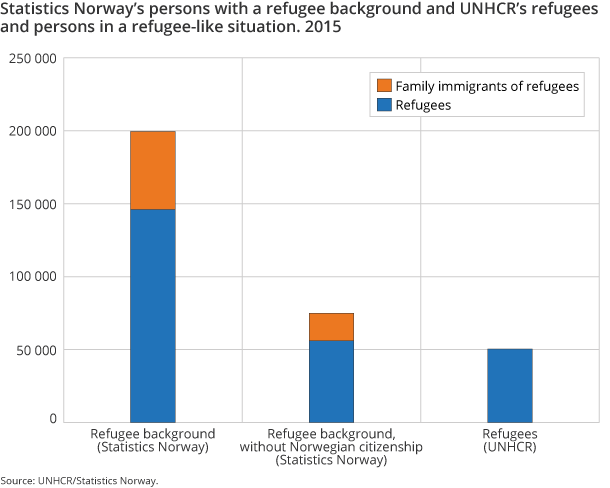Statistical analysis, 2017
International statistics on refugees – collection and dissemination challenges
Record numbers of displaced persons
Published:
This article was first published in Norwegian, in Statistics Norway’s journal Samfunnsspeilet: Aalandslid, Vebjørn (2016): Internasjonal statistikk over flyktninger – utfordringer med innsamling og formidling. Rekordmange mennesker på flukt. Samfunnsspeilet 4/2016. Statistisk sentralbyrå.
The United Nations High Commissioner for Refugees (UNHCR) reported last year that 65 million people have been displaced globally. This figure is the highest since World War II, both for those who have left their homeland and those who are displaced within their own countries. Meanwhile, there is growing concern about the quality and availability of statistics on refugees. Statistics Norway is working with the UNHCR to improve these figures.
- Series archive
- Statistical analysis, 2017
The refugee problem primarily affects the refugees themselves, but also the countries they flee to and the international community. In order to understand the situation in Norway, we need to step back and consider the global perspective.
The UNHCR has a global mandate to protect the rights of refugees, and is also responsible for keeping track of how many people are displaced throughout the world. National and international organisations are dependent on accurate figures and statistics in order to plan initiatives and distribute resources to aid the refugee crisis. The UNHCR is the only organisation that can provide a global overview, and every year publishes a report showing the number of people displaced (UNHCR Global Trends). Some of the key figures in the report are presented in this article.
At the end of 2015, the UNHCR reported that around 41 million people were displaced within their own country, 21 million were refugees (had crossed their national border), while 3 million were asylum seekers; a total of 65 million displaced persons (see box for definitions). This is the highest number of displaced persons that the UNHCR has registered since the flood of refugees in the aftermath of World War II.
Since 2011, there has been a marked increase in the number of displaced persons in the world (see Figure 1), and compared with the situation in the 1990s and 2000s, numbers have increased by over 50 per cent. This is mainly due to the war in Syria, the country with the most internally displaced persons (IDPs) and the second most refugees after Palestine (see Figures 2 and 3). In 2015 alone, the number of Syrian refugees rose by more than one million, with most seeking refuge in Turkey. In the second half of 2015, many made their way to Europe.
Over half of the world’s refugees are from three countries; Syria, Palestine and Afghanistan. Figure 2 shows the ten largest country groups. Overall, refugees from these ten countries account for more than three-quarters of all refugees worldwide.
Norway has large numbers of refugees from the major refugee countries, such as Somalia, Iraq and Afghanistan, but few from countries like Congo, Sudan and Central African Republic. The majority of refugees from these countries also mainly stay close to home, with few leaving their own part of the world.
More than two-thirds are displaced in their own country
Displaced persons are often found in their own country: two out of three are internally displaced (refugees) in their homeland. The UNHCR’s statistics on IDPs began in the early 1990s. The number of IDPs has doubled from the 1990s to the present day, as shown in Figure 1.
As with the refugees who have left their homeland, the large number of IDPs is concentrated in a few countries. Seventy-five per cent of all IDPs are found in one of the ten countries illustrated in Figure 3. Syria has 6.6 million, making it the country with the most IDPs. In 2014, the figure was even higher, at 7.6 million. The subsequent decline is due to many choosing to leave the country in 2015.
Colombia has the second largest number of IDPs in the world. The number has been high for several decades. Millions of farmers in rural areas are being forced to flee as a result of civil war and conflicts with the FARC guerrillas and right-wing paramilitary groups.
Asylum seekers come to Europe, refugees stay in the southern hemisphere
Of the roughly 3 million asylum seekers in 2015, almost half came to Europe and North America, while the vast majority of the world's refugees, according to UNHCR records, stay in Africa and Asia. UNHCR figures from 2015 show that Europe received 34 per cent of the world's asylum seekers, while 9 per cent applied to North America. If we disregard the extraordinarily large number of cases that accumulated over time in South Africa, as many as two out of three of the world's asylum seekers went to Europe or North America in 2015. Six of the ten largest host countries were in Europe (see Figure 4).
Last year saw a sharp increase in the figures for Europe. In 2015, 442 000 persons applied for asylum in Germany, the country in Europe that received most asylum applications. The UNHCR provides an overview of the number of asylum seekers in a country at the end of the year. Figures from Eurostat, which supplement the UNHCR figures, show that Norway received 31 000 applications in 2015. Eleven European countries received more asylum applications than Norway. Germany had the most applications, followed by Hungary and Sweden (Eurostat 2015a).
The number of asylum seeker registrations has continued to grow in Germany in 2016, and monthly figures have been just as high as in 2015. So far this year (October 2016), more than 600 000 new asylum applications have been registered in Germany. However, most of the registrations in 2016 are a result of a backlog from 2015, as there was actually a sharp fall in new asylum seekers in Germany last year. This is also the case for Sweden and Norway, according to Eurostat figures. As of September 2016, 20 000 applications for asylum had been received in Sweden and 2 500 in Norway.
Almost 90 per cent of refugees and IDPs reside in Africa, Asia and Latin America, according to the UNHCR. Turkey has the most, with 2.5 million refugees: mainly from Syria but also from Iraq. Then follows Pakistan, which hosts 1.5 million refugees, almost all of whom are from Afghanistan, and many have lived in the country for more than 30 years. Lebanon is the third largest host country for refugees. Around one million Syrian refugees live in the country and, according to UNHCR figures, almost 20 per cent of the country’s population are refugees.
How are refugees counted and when does a refugee stop being a refugee?
There are large disparities between individual countries in how the number of displaced persons is reported to the UNHCR. Many countries have reliable figures on border crossings, asylum applications etc. Far fewer keep accurate records of IDP numbers.
The UNHCR primarily has an operational approach since it needs to know the figures in order to plan its relief work. Some countries have effective systems for registering and maintaining an overview of their refugees and have a good cooperation with the UNHCR, which receives detailed statistics. However, too many countries lack adequate national data sources to keep track of the refugee situation.
The UNHCR may, for example, receive summary figures from the authorities, but cannot break them down by age or gender. They are therefore of little use in planning the relief work. In many countries, the figures are not made available to the UNHCR. In such cases, the organisation is dependent on secondary reporting by other UN agencies or voluntary/private organisations. The UNHCR has access to its own data in the largest refugee countries where it has major operations – for example, from registers at refugee camps operated by the UN. The problem with these statistics is that they only include refugees living in the camps, not other refugees in the country. With a growing number of refugees not living in camps, this figure is becoming less indicative of the situation.
Most countries in the world do not have good population registers, nor is there any exchange of data between national immigration authorities and national statistical offices. There is often differences between the international statistics and the statistics of individual countries on the refugee situation, and figures also vary between the different international reporting organisations.
The disparities are partly caused by different data sources being used, as well as different definitions of who is a refugee. The UNHCR's primary focus is on the group of refugees who have an immediate need for help, while some countries are more interested in examining whether the refugees are integrating into the labour market and the education system.
Norway’s figures show a disparity of 100 000
Elsewhere in this publication, we have shown that, according to Statistics Norway, around 200 000 persons with a refugee background are living in Norway. Approximately 146 000 arrived here as primary refugees, while around 55 000 are family immigrants to such persons. UNHCR figures for 2015 show a total of 50 000 refugees in Norway; a disparity of almost 100 000. Similar disparities are also found in some of the statistics in other European countries.
Norway is one of few countries to compile annual figures on refugees based on information from both a population register and from immigration administration records. In Denmark and Sweden, the statistical offices compile an annual overview of immigrants by reason for immigration, showing the number of (new) refugees. In other European countries, only the immigration authorities produce figures, but some statistical offices provide estimates of the number of persons with a refugee background based on sample surveys.
One example of this is the statistics based on the European labour force survey. In 2014, the German statistical office reported that there were 733 000 residents with a refugee background of working age in Germany (Eurostat 2015b). This figure was based on a large questionnaire asking about the main reasons for immigration, and was almost three times higher than the UNHCR’s figure for Germany in 2014, i.e. 216 000. As discussed, such disparities are found for several countries.
UN figures based on ‘lasting solution’
UNHCR estimates are based on the number of asylum seekers who have been granted residence in the country over a ten-year period, and build on individual decisions, irrespective of subsequent emigration or death. After ten years, it is assumed that a lasting solution (as defined by the UNHCR) has been found, or that the refugee has been naturalised in the host country, and is therefore no longer covered in the statistics. Furthermore, resettlement refugees are not included in UNHCR’s figures since it is believed that this group was given a lasting solution in the host country upon their arrival.
The UNHCR says it adopts this approach in all industrialised countries, while in Africa, Asia and Latin America the refugee status remains unchanged for the most part. In addition, children born in refugee camps in these parts of the world are included in the refugee numbers, which pushes up the numbers even when no new refugees have arrived in the country.
One consequence of this practice is that the figures are not fully comparable either within or outside Europe. Refugees who came to Europe in the 1990s and early 2000s are not, for example, included in the statistics, while in Asia we find refugees dating back to the 1950s. The UNHCR has been criticised for this as its figures are often cited in the debate on sharing the refugee burden.
For Norway’s part, the UNHCR’s approach leads to much poorer figures than those produced in Statistics Norway. Statistics Norway’s figures are updated annually for persons with a refugee background. Because the figures are based on data from the population register, subsequent emigration and deaths are factored in.
Statistics Norway can also provide figures on the number of persons with a refugee background who have been naturalised, which is something that the UNHCR would like to show. Figure 5 illustrates this disparity.
Several organisations contribute to international statistics
The UNHCR has the main global responsibility for collecting data and producing aggregate annual statistics on displaced persons throughout the world. However, the UNHCR is not the only organisation to do so.
A number of organisations create statistics at various regional levels. The statistical office of the European Union, Eurostat, compiles statistics of asylum seekers coming to Europe. The International Organization for Migration (IOM) maps global migration flows (including refugees) in dedicated databases, and compiles figures for various migration routes in Europe. The United Nations Relief and Works Agency for Palestine (UNWRA) is the only organisation that keeps track of people displaced from the Palestinian Territories. The Norwegian Refugee Council (NRC) produces an annual report (Flyktningregnskapet) showing the number of people displaced. The report compares data from several different sources and helps highlight global trends with more country-specific figures.
National immigration authorities and a few national statistical offices, such as Statistics Norway, also produce figures. In the world of statistics, Statistics Norway is about the only statistical office that produces annual figures on the demography and living conditions of refugees.
Statistics on IDPs are particularly challenging. There is no international legal framework for the protection of IDPs, so registering and monitoring this group is a national responsibility. Access to reliable data varies from country to country, as does the willingness and ability to collect such figures. In many cases, countries have a vested interest in concealing information about IDPs.
No international organisation has a clear international mandate to create statistics for this group, such as the UNHCR has for refugees. The Internal Displacement Monitoring Centre (IDMC), which is supported by the NRC, attempts to produce estimates of the number of IDPs based on figures from secondary sources and data from individual countries (to the extent this is available) and various UN agencies and NGOs.
Cooperation between UNHCR and Statistics Norway
Together with the UNHCR, Statistics Norway has recently prepared a report on the challenges of collecting, producing and disseminating statistics on refugees and IDPs (UNHCR/Statistics Norway 2015). The report was presented and discussed at the annual meeting of the United Nations Statistical Commission (UNSC) in New York in March 2015. This was the first time since the UNSC was established in 1947 that statistics on refugees were given their own spot on the agenda at the annual meeting.
The report refers to good examples of the cooperation between statistical agencies and immigration authorities, and how this may be transferable to other countries. Norway is highlighted as an example of a country where the refugee statistics are an integral part of the overall migration and population statistics. The report notes that there are currently no international regulations or recommendations for refugee statistics. In 1998, the UN created a set of international recommendations on migration statistics, where asylum seekers and refugees were barely discussed and IDPs were not mentioned at all.
The UNSC decided that Norway and the UNHCR should continue this work and develop a set of international recommendations for refugee statistics. The specifics were explained at the Commission meeting in 2016, and together with the UNHCR and Eurostat, Norway was asked to head a group of experts to draw up international recommendations for good-quality refugee statistics. The main purpose of these recommendations is to establish a better cooperation between the UNHCR, the migration authorities in the individual countries and the statistical offices.
The expert group will also make recommendations on how to improve the statistics on IDPs.
References:
UN High Commissioner for Refugees. (2016). Global trends: Forced displacements in 2015. Retrieved from http://www.unhcr.org/576408cd7.pdf
Flyktninghjelpen. (2016). Flyktningregnskapet 2016. Retrieved from https://www.flyktninghjelpen.no/flyktningregnskapet-2016/
Eurostat (2015a). Asylum and managed migration. Asylum by citizenship 2015. Retrieved from http://appsso.eurostat.ec.europa.eu/nui/show.do?dataset=migr_asyappctza&lang=en
Eurostat (2015b). LFS ad hoc modules on migrations. First generation of immigrants by sex, citizenship, duration and reason for migration. Retrieved from http://appsso.eurostat.ec.europa.eu/ nui/show.do?dataset=lfso_14b1dr&lang=en
UNHCR & Statistics Norway (2015). Report of Statistics Norway and the Office of the United Nations High Commissioner for Refugees on statistics on refugees and internally displaced persons. Report presented at United Nations Statistical Commission Forty-sixth session, 3-6 March 2015. Retrieved from http://unstats.un.org/unsd/statcom/ doc15/2015-9-RefugeeStats-E.pdf
Contact
-
Statistics Norway's Information Centre

